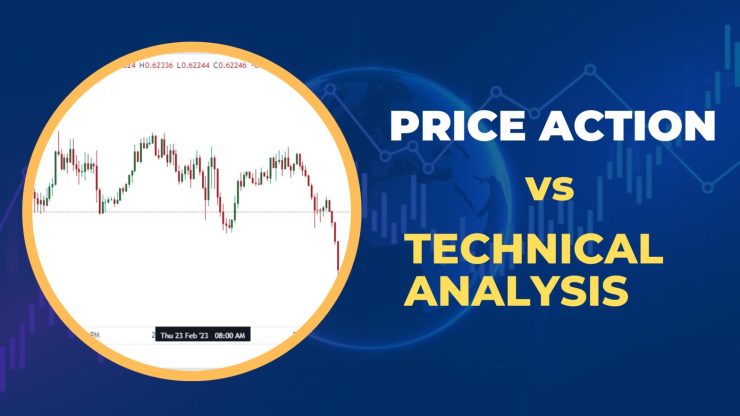Price action and technical analysis are commonly used by traders to analyze financial markets and make proper trading decisions.
In other words, Price action is solely based on using past price movements to provide valuable information about market trends, while technical analysis relies on the use of charts and indicators + other technical tools to identify patterns and potential trade opportunities.
Both approaches have their advocates and detractors, and the debate over which method is more effective is a long-standing one in the world of trading.
In today’s post, we will explore the key differences between price action and technical analysis and their respective strengths and weaknesses, helping you to make an informed decision about which approach is best suited to your trading style and objectives.
Key things to note:
- Technical analysis itself involves the use of price action and/or technical indicators
- Price action is a branch of analysis that uses the price of a security as a means to analyze the market
- Technical indicators (analysis) are computerized systems that use complex mathematical analysis to predict the future of prices.
What is Price Action Trading?
Price action analysis involves the comparison between what has happened to prices in times past (recent past) and using suitable price action patterns to look for the direction in which price is headed next.
This kind of technical analysis uses support and resistance majorly as entry and exit points.
Due to the fact that all technical indicators are built based on what price has done in the past, price action analysts believe that reading naked charts would be best since indicators rely on price action.
So what are the benefits of price action?
Advantages Of Price Action Trading
Price action is often regarded as a leading signal. Why? This is because it helps to identify the direction of the market as soon as it forms and hence, provides traders with a very juicy risk-to-reward ratio since they are able to join the trend early.
Price action is quite simple because you already know when your preferred price pattern forms leading you to react without any other external influence.
When you’ve known how to read and interpret prices at the professional level, identifying your position of entry and exit would be of no stress using support and resistance (supply and demand) zones.
Drawbacks of Price Action Trading
Even with the benefits that price action offers, it, however, has some downfalls. These are:
Price action patterns do not always appear exactly the same all the time which can lead to difficulty when interpreting. Because of this, some price action traders fall into the trap of jumping too early into trades.
Price action traders usually see the markets differently even when using the same chart which often leads to disparity among them.
Interpreting price patterns would require some level of knowledge about how they form and the psychology behind them.
What are Technical Indicators?
Technical indicators are a programmed system of trading that uses some set of programs to solve complex mathematical calculations using some rules, in order to simplify how price moves.
They make their calculations from past price action to be able to roughly estimate the strength and weakness of a particular security.
Technical indicators calculate based on past price actions such the volume, price, open interest and others not considering fundamental news drivers such as revenues, employment rates, etc which affect the movement of a security.
Some of the most popular indicators are the Moving average, stochastic, and the Bollinger band RSI(relative strength index) among others.
So how can they be of benefit to you?
Advantages Of Technical Indicators
Since they are programmed, they can be easily automated to generate signals.
Traders only have to wait for the crossing over of indicators with the price to take trading positions.
Trading with technical indicators appears simpler because you don’t need to have a vast knowledge of price.
All you have to do is to wait for it to provide the buy and sell signals.
Since it allows you to visualize how price reacted when that kind of signal had formed in the past, it, therefore, provides a visual presentation of ideas.
Disadvantages of Technical Indicators
Since technical indicators work with past price actions, the signals provided by them are often lagging.
Hence, it can be referred to as a lagging indicator.
This makes joining a trend very late. Price would have already formed the trend before indicators would give a trend signal.
Different technical indicators give different market signals which means they can be very confusing especially when you don’t know how to combine their uses.
Relying on technical indicators alone causes traders to miss out on some juicy trading opportunities.
Technical indicators are largely prone to give false market signals since they don’t always agree.
Hence, relying on them can make you miss out on opportunities.
Most traders in this category are tempted to believe that there is a 100% always-winning holy grail indicator which is far from the truth.
So Which Of Them Is Best For You?
The answer to this question now depends on you and your choice.
Some people understand price action and are able to make a huge chunk of money from it while others make their profit from the use of technical indicators.
I strongly advise you to make use of a demo trading account to know which of them suits you best.
Sometimes, traders combine their uses together to make money and there is no problem in doing so.
At times, price action might not give entry opportunities, especially in a range-bound market structure whereas technical indicators may provide opportunities to trade.
In most cases, technical indicators will not just be the best and won’t give sharp entry opportunities but price action will get you covered in crucial times like this.
Final Words
When choosing which one suits you best, make sure you understand the pros and cons associated with each of them.
However, combining the benefits of both might be the better option for you if you understand the nitty-gritty behind them.
Here is a simple way to choose which one suits you best.
If you know you won’t be able to give out time to learn price action in detail (which I advise you to do), then an indicator-based system might be the one for you.
But if you want to understand the price in detail, how and why it moves, make smart trading decisions, and have a good risk-to-reward ratio, then price action trading would be best for you.
In all, you should always use good and profitable risk management techniques and set realistic goals and expectations when using Price Action or Technical Indicators.


